Sheep
Ovis aries
Sheep were one of the first and most successful domesticated species in the world.
Advertisement
Sheep Scientific Classification
- Kingdom
- Animalia
- Phylum
- Chordata
- Class
- Mammalia
- Order
- Artiodactyla
- Family
- Bovidae
- Genus
- Ovis
- Scientific Name
- Ovis aries
Read our Complete Guide to Classification of Animals.
Sheep Conservation Status
Sheep Facts
- Main Prey
- Grass, Weeds, Flowers
- Group Behavior
- Flock
- Fun Fact
- Sheep were one of the first and most successful domesticated species in the world.
- Habitat
- Grass plains and mountainous regions
- Diet
- Herbivore
- Average Litter Size
- 1
- Lifestyle
- Flock
- Favorite Food
- Grass
- Type
- Mammal
- Slogan
- Around 35 million in the English countryside!
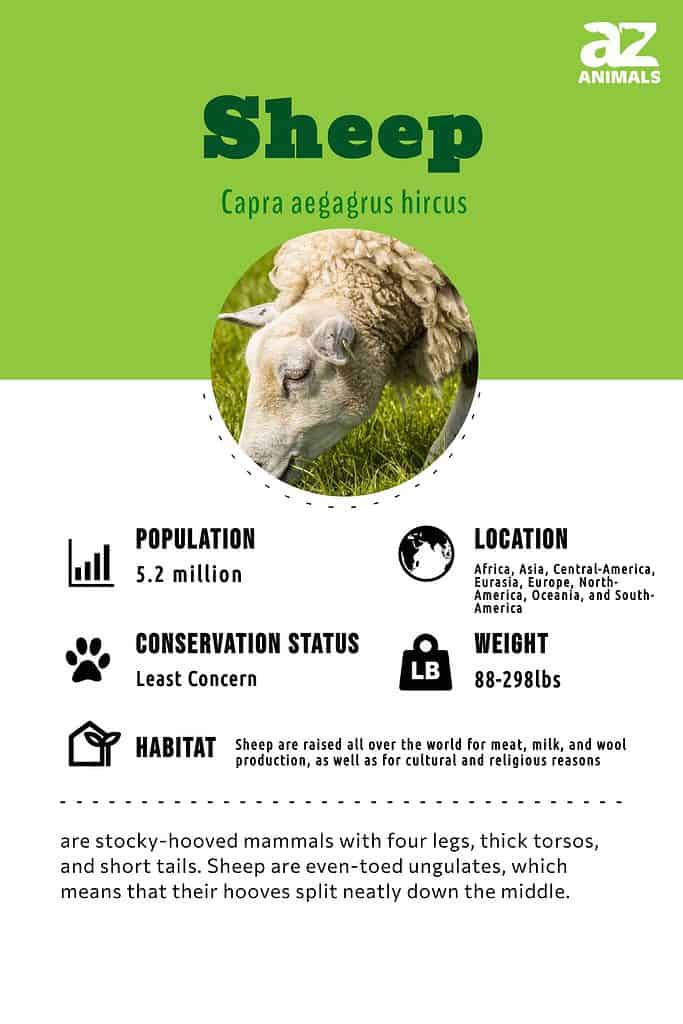
“Sheep were one of the first and most successful domesticated animals in the world.”
With sweet faces, gentle personalities, and endless amounts of fluffy white wool, it’s no surprise that sheep are some of the most popular livestock animals in existence.
There are more than one billion domestic sheep and several subspecies of wild sheep that can be found around the globe. Some sheep are raised for wool, and others are raised for meat; but either way, these animals are an important part of nearly every culture.
3 Incredible Sheep Facts
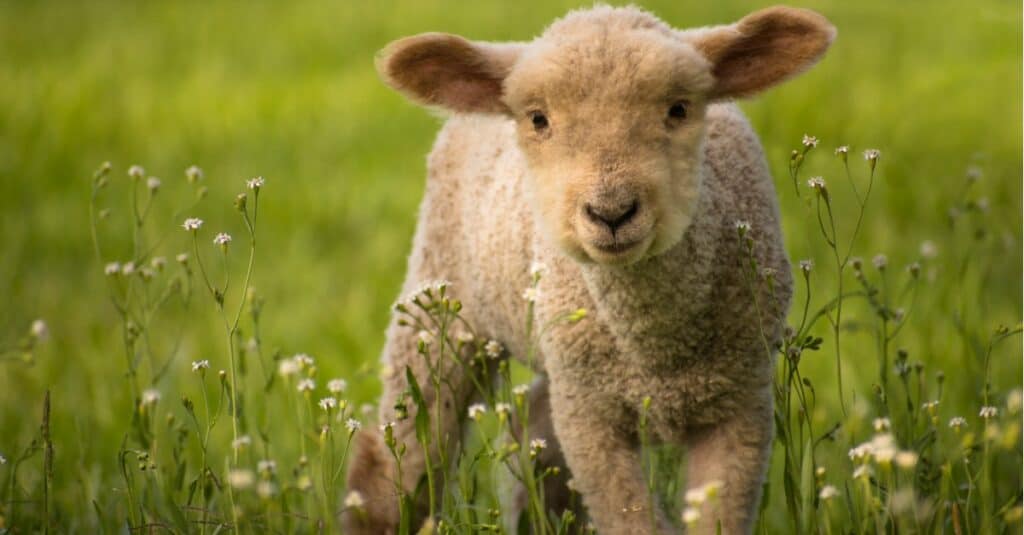
Sheep are animals that have a set of baby teeth that they lose as they get older. Most get their adult slowly and won’t have a full set of teeth until they are 4 years old.
©iStock.com/Sebastian Jakimczuk
- Growing teeth: Like humans, sheep are animals that have a set of baby teeth that they lose as they get older. Most get their adult slowly and won’t have a full set of teeth until they are 4 years old.
- Winter coats: The wool that farmers collect when shearing these animals is actually an undercoat that grows beneath their main coat of fur. Wild sheep get these undercoats in the winter and will shed them when the weather warms up. Domestic sheep have been bred to never shed.
- Family dynamics: Sheep are animals that love their families and will stick close to their mother and their siblings. In a large flock, you may notice that related sheep are always standing near each other.
Scientific Name
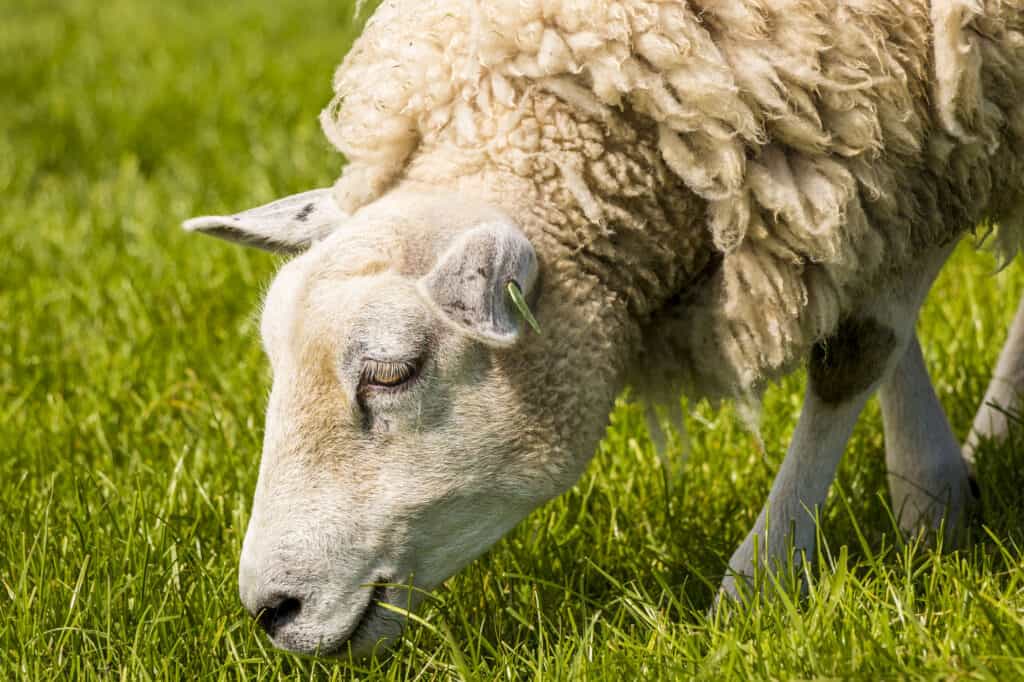
The scientific name for the domestic sheep is
Ovis aries
.
©iStock.com/MarjanVisser
The scientific name for the domestic sheep is Ovis aries. The Latin etymology of this name includes “ovis,” which means “sheep,” and “aries,” which means “ram”. There are several different species that fall under the genus Ovis, and all of them are frequently referred to as “sheep.” Non-domestic examples include the bighorn, the mountain, and the snow sheep. All sheep are part of the Mammalia class and belong to the Bovidae family and the Caprinae subfamily.
Like many domestic species, there are different names for sheep of different genders and ages. A female is called a “ewe,” and a male is called a “ram.” A neutered male is often referred to as a “wether.” Baby sheep are called lambs, and 1-2 year-olds are called “yearlings.”
Evolution and Origins
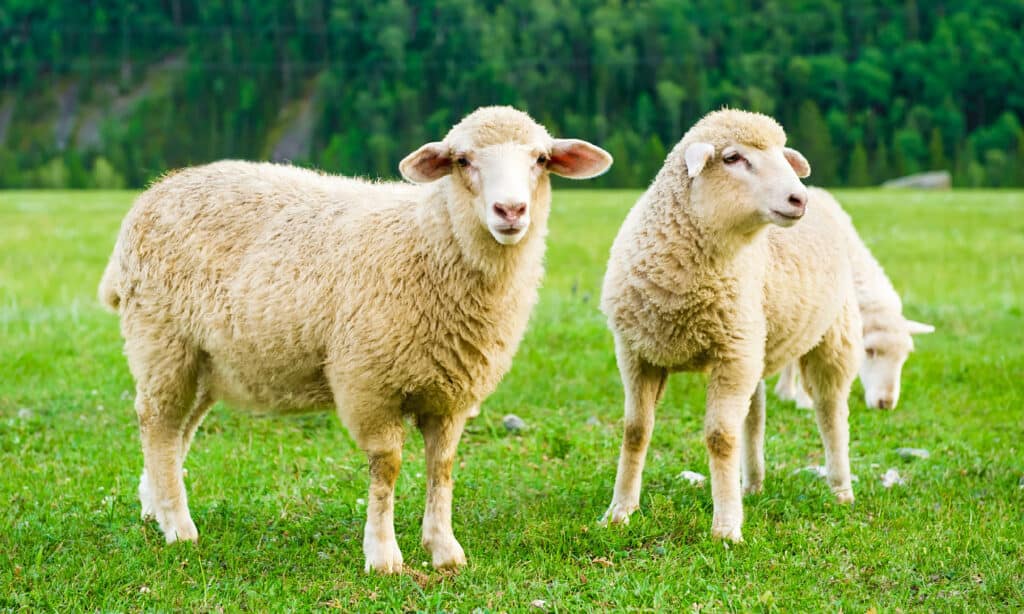
The origins of sheep can be traced back to the wild mouflon, a wild sheep that still exists in the mountains of Asia and Europe.
©iStock.com/idal
The origins of sheep can be traced back to the wild mouflon, a wild sheep that still exists in the mountains of Asia and Europe. These wild sheep have been domesticated around 8000-9000 years ago in the Middle East and Central Asia. Domestication likely occurred because of the animals’ adaptability to a wide range of environments, as well as their suitability for meat, milk, and wool production.
Over time, sheep were selectively bred to enhance certain characteristics, such as increased wool production and meatier bodies. This process led to the development of the many different breeds of sheep that exist today.
As sheep were domesticated and spread to different regions of the world, they encountered different environments and selective pressures. This led to the evolution of different breeds of sheep that are adapted to specific conditions. For example, some sheep breeds are better suited to cold climates and produce thicker wool, while others are better suited to hot climates and produce less wool.
Today, sheep are raised all over the world for meat, milk, and wool production, as well as for cultural and religious reasons. With the advancement of technology, the breeding and management of sheep have also become more scientific, leading to even more efficient production.
Different Types of Sheep
- Dorper
- Merino
- Valais Blacknose
- Suffolk sheep
- Texel sheep
- Priangan sheep
- Awassi
- Cameroon sheep
- Ladoum
- Scottish Blackface
- Hampshire Down
- Dorset Horn
- Ouessant sheep
- Southdown sheep
- Montadale
- Herdwick
- Harri
- Romanov sheep
- Corriedale
- Lacaune sheep
- Ryeland
- Racka
- Royal White
- Wiltipoll
- Polypay
- Meatmaster
- Coopworth
- Wiltshire Horn
- Jacob sheep
- Katahdin sheep
- Uda sheep
- Najdi sheep
- Columbia sheep
- Shetland sheep
- Assaf sheep
- Lonk
- Karakul sheep
- Pelibüey
- Rambouillet sheep
- Australian White sheep
- Cheviot sheep
- Marco Polo sheep
- Icelandic sheep
- Barbados Black Belly
- Border Leicester
- Soay sheep
- Charollais sheep
- Romney sheep
- East Friesian sheep
- Bluefaced Leicester
- Swaledale sheep
Appearance and Behavior
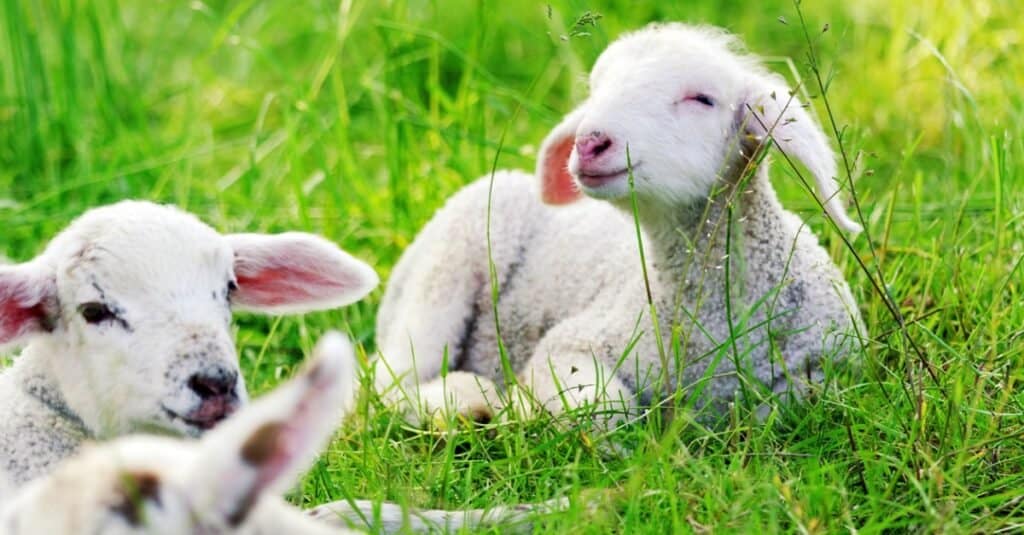
Sheep are stocky-hooved mammals with four legs, thick torsos, and short tails.
©iStock.com/Matthäus Rojek
These animals are stocky-hooved mammals with four legs, thick torsos, and short tails. Sheep are even-toed ungulates, which means that their hooves split neatly down the middle. All of these animals are covered in thick hairs that are supported by a soft wooly undercoat.
Domestic sheep have been bred to be particularly fluffy, but wild sheep usually have sleeker silhouettes that are more appropriate for mountainous environments.
Both wild and domestic sheep can have horns, but wild species tend to have far more impressive spirals. As with most species, the rams will almost always have larger horns than the ewes. Some domestic sheep have been bred to have no horns at all.
These animals are shorter than other ungulates. Most domestic sheep are about 4-5 feet long and stand about 2-4 feet high. A male can weigh anywhere from 100-350 pounds, while females tend to stop growing at 220 pounds. The fluffy wool that they are known for tends to make them look bigger than they actually are, and the impressive
These animals live in flocks and almost never separate from the other members of their group. Lost sheep get incredibly distressed and will bleat loudly until they find their flock or their human caretaker. Within their flocks, they have a strong sense of family.
If you observed a large flock, you might notice the animal hanging out with their siblings, parents, and grandparents. When the flock leader moves to another pasture, the rest of the flock will follow; this is why these animals are such a popular choice for domestic livestock.
Sheep vs. Goat
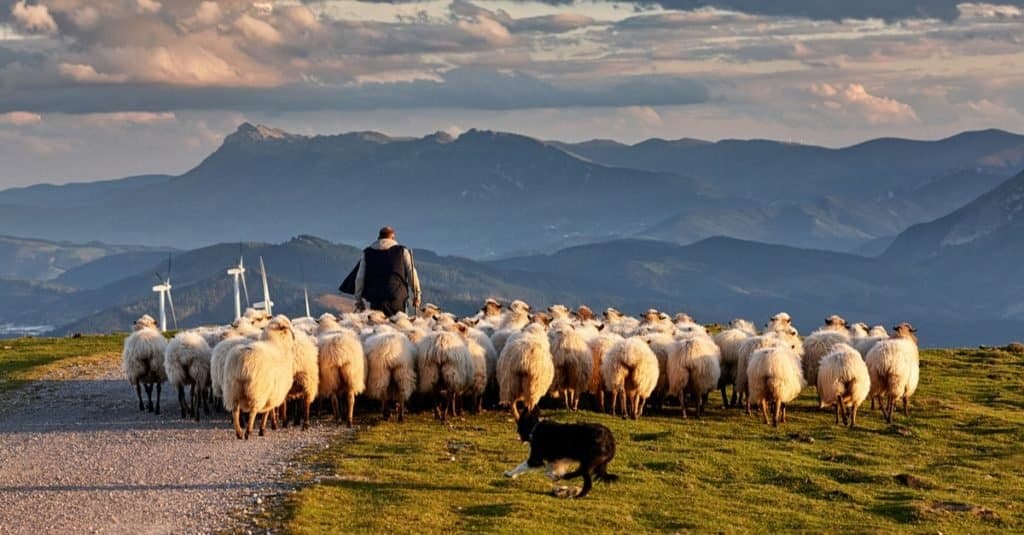
The scientific name for
goats
is
Capra aegagrus hircus.
©Jesus Keller/Shutterstock.com
The scientific name for goats is Capra aegagrus hircus. Sheep and goats are easy to confuse from a distance. However, if you’ve ever interacted with either of these animals, you’ll quickly see the differences between these two members of the Caprinae family.
- Faces: Goats usually have beards, but domestic and most wild sheep do not. Goats also always have horns; unlike sheep, the base of a goat’s horns typically points straight upward.
- Diet: Sheep are grazers that slowly eat grass and weeds throughout a pasture. In comparison, goats are browsers who will pick the leaves off a single plant before moving on to the next one.
- Behavior: Sheep live in flocks and are prone to follow. Goats live in herds and are very social animals, but they have an independent streak that is immediately obvious to anyone who interacts with them.
Habitat
Domestic sheep have been living alongside humans for thousands of years. Because of their thick wool coats, they are capable of living in almost any climate. All they need is shelter, water, and a large grassy pasture where they can graze. Because of the need for grass, domestic sheep are commonly raised in foothills, plains areas, and other places with large stretches of land.
Wild sheep are found in nearly every mountainous region in the world. Bighorn sheep are particularly common in the Rocky Mountains of North America. However, you can also find these animals scattered throughout Europe, Asia, and the Middle East. They are excellent climbers with hardy lungs and are capable of living at elevations of up to 19,600 feet.
Diet
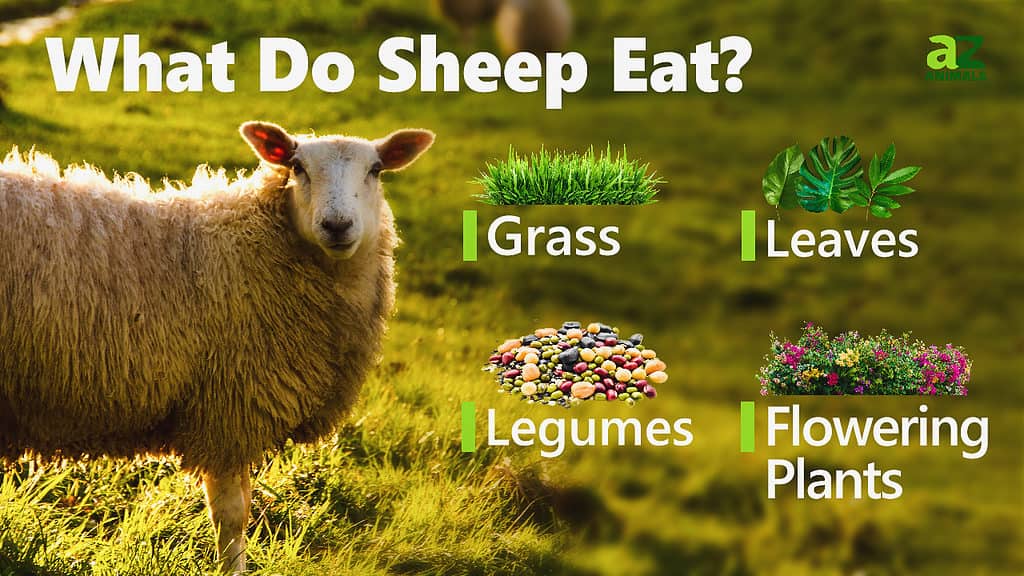
These animals are a type of herbivore known as a ruminant. This means that they have a complex, multi-stomach digestive system designed to break down the cellulose that’s present in grass and hay. Ruminants require a lot of food to survive, and they need to work to digest it; that’s why they spend most of their time eating and chewing their cud.
The animal’s minimum daily consumption is about 0.03 pounds of grass or hay for every pound of body weight. This means that a 100-pound animal needs to eat 3 pounds of hay every day to maintain healthy body weight. Younger animals tend to eat more than this, and cold weather always calls for an increase in feed.
In the summer, most farmers who own these animals prefer to feed them on a rotating pasture system. This means letting your flock out to pasture on one grass field until it starts to thin. Then, switch your animals to a different pasture, and allow the first one to grow back. Sheep graze incredibly quickly, so you may need to own a lot of lands to make this system work.
Hay is an excellent choice for animals who must be kept indoors, especially in the wintertime. Always use normal hay, as alfalfa hay has an incredibly high level of calcium. Similarly, you should make sure that any pasture your flock is let into has been cleared of toxic weeds.
Finally, if you’re looking to give your animals a treat, they do enjoy munching on grains, vegetables, and fruits. Good choices include apples, oats, carrots, and lettuce. Don’t feed these animals too many treats; if a sheep eats too much of something that isn’t grass, they risk bloating their stomach and experiencing a great deal of discomfort.
Predators and Threats
These are hooved mammals, making them a prime target for large carnivores in every part of the world. Some of the most dangerous threats to sheep include wolves, mountain lions, and coyotes. Most farmers have to work hard to make sure that predators don’t come anywhere near their flock while they are out to the pasture.
These animals have no way to defend themselves, so they usually rely on their human caretakers and their herding dogs. A good fence will do more for the mental security of your flock than any other security measures. Most shepherds count the members of their flock carefully to make sure no one gets left behind before the barn doors are shut at night.
Wild sheep are not aggressive, but they tend to get scared by the presence of humans. Deforestation and over-development have both contributed to the slow reduction of sheep-friendly habitats across the globe. With that said, most wild sheep are listed as being of least concern for conservation efforts.
Reproduction, Babies, and Lifespan
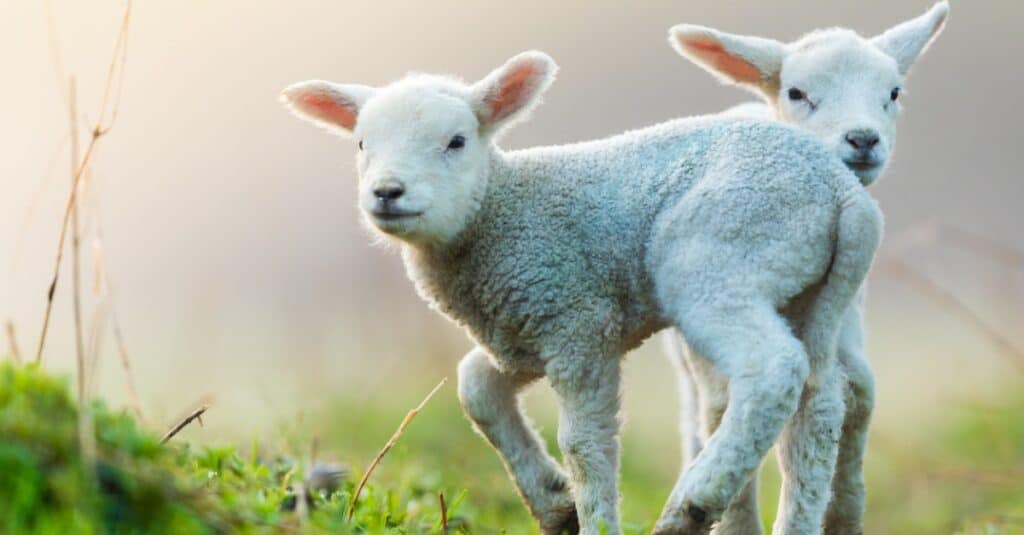
Ewes don’t typically show signs of pregnancy until about a month and a half before the delivery date, so it can be difficult to tell if they are carrying a lamb.
©iStock.com/Jag_cz
A flock of sheep generally consists of a single ram and as many ewes as he and the farmer can take care of. Large flocks may have two rams, but there is a good chance that they will fight with one another to establish dominance. The dominant ram will typically mate with every non-related ewe in his flock.
An ewe’s pregnancy lasts for an average of five months. Ewes don’t typically show signs of pregnancy until about a month and a half before the delivery date, so it can be difficult to tell if they are carrying a lamb. However, just before delivery, the ewe will start showing obvious signs of discomfort and may begin looking for a place to give birth.
Ewes typically give birth to between 1 and 3 lambs at a time, with pairs of twins being the most common. Lambs usually weigh somewhere between 5-10 pounds when they are born, and they gain about half a pound a day for 2-3 months. Lambs are old enough to be separated from their mothers at around 6 months old; however, because they like to flock together with their families, this separation is not often recommended.
These animals do not reach sexual maturity until they are around 1 year old. Because many females have not reached their full size or emotional maturity by this point, many farmers recommend waiting until a sheep is around 2 years old to breed them. For their safety, yearlings are typically separated from the rest of the flock when breeding season occurs.
A well-loved sheep typically lives to be around 12 years old. The oldest sheep that ever lived was named Methuselina, and she made it to the impressive age of 28 years old. As they get older, sheep start to produce wool more slowly. They may also start to show symptoms of arthritis, weariness, and generally poor health.
Population
There are well over one billion domestic sheep currently scattered across the globe. The country with the most sheep is China with an impressive total of 187 million individual sheep at one time.
Wild sheep populations are not particularly well-tracked, especially in the rural and undeveloped areas where these sheep like to live. There is an estimated total of 700,000 bighorn sheep remaining in North America. Because this population is stable, bighorn sheep are considered to be of least concern.
Sheep in the Zoo
One of the best places to see a bighorn sheep is at the Denver Zoo. You can also find desert bighorns at the Los Angeles Zoo. However, if you want to see domestic sheep in person, your best bet is to visit a local farm that allows you to meet their livestock.
View all 293 animals that start with SSheep FAQs (Frequently Asked Questions)
Are Sheep herbivores, carnivores, or omnivores?
Sheep are Herbivores, meaning they eat plants.
What Kingdom do Sheep belong to?
Sheep belong to the Kingdom Animalia.
Are sheep carnivores, herbivores, or omnivores?
All members of the Ovis genus are herbivores. Sheep typically only eat hay, grass, and a few grains or vegetables as snacks.
What is the difference between a sheep vs. goat?
Sheep and goats are both members of the Caprinae family. Sheep belong to the Ovis genus, and goats belong to the Capra genus. The main difference between sheep and goats is that sheep flock together and have very socially dependent personalities, while goats live in a herd but have a great deal of personal independence. You can tell sheep and goats apart by looking at their faces; goats have beards and straight horns, while sheep have no beards and have small or curly horns that point out at an angle.
What do sheep eat?
Sheep primarily eat hay and grass. Although they might eat a piece of apple as a treat, sheep can’t eat too many fruits and vegetables without risking a bloated stomach.
What is the personality of a sheep?
Sheep have sweet, family-oriented personalities. Expect your sheep to be relatively docile as long as you are following a standard routine. Be aware that every sheep may have his or her own personality.
What do you call a female sheep?
Female sheep are called ewes. Male sheep are usually called rams, and neutered male sheep are called wethers.
Are sheep aggressive?
Sheep are not particularly aggressive towards their handlers or other sheep. However, they may not enjoy interacting with strangers; flocks have been known to push out unwanted company with minor headbutts and kicks.
What is the plural of sheep?
The plural of the word “sheep” is simply “sheep.” To avoid confusion, some people like to say “a single sheep” and refer to the plural as “a flock of sheep.”
What family do Sheep belong to?
Sheep belong to the family Bovidae.
What order do Sheep belong to?
Sheep belong to the order Artiodactyla.
What type of covering do Sheep have?
Sheep are covered in Wool.
What genus do Sheep belong to?
Sheep belong to the genus Ovis.
In what type of habitat do Sheep live?
Sheep live in grass plains and mountainous regions.
What are some predators of Sheep?
Predators of Sheep include humans, wolves, and coyotes.
How many babies do Sheep have?
The average number of babies a Sheep has is 1.
What is an interesting fact about Sheep?
There are around 35 million Sheep in the English countryside!
What is the scientific name for the Sheep?
The scientific name for the Sheep is Ovis aries.
What is the lifespan of a Sheep?
Sheep can live for 5 to 10 years.
How fast is a Sheep?
A Sheep can travel at speeds of up to 25 miles per hour.
What is the difference between a ram and a sheep?
Ram vs sheep: turns out they’re the same animal!
How do sheep eyes vs goat eyes compare?
Goat eyes and sheep eyes are extremely similar. Some differences between the two include sheep eyes having a wider field of vision and being lighter brown or blue while goat eyes are often brown or greenish-tan.
Thank you for reading! Have some feedback for us? Contact the AZ Animals editorial team.
Sources
- Wikipedia, Available here: https://en.wikipedia.org/wiki/Sheep
- Britannica, Available here: https://www.britannica.com/animal/sheep
- Sheep 201, Available here: http://www.sheep101.info/201/behavior.html
- Treehugger, Available here: https://www.treehugger.com/difference-between-sheep-and-goats-4858720
- Sheep 101, Available here: http://www.sheep101.info/eating.html
- Cloverworks Farm, Available here: https://cloverworksfarm.com/what-do-sheep-do-all-day/
- The Open Sanctuary Project, Available here: https://opensanctuary.org/article/daily-diet-treats-supplements-for-sheep/
- Research Gate, Available here: https://www.researchgate.net/figure/Ranking-of-countries-based-on-sheep-population_tbl4_332947789

















